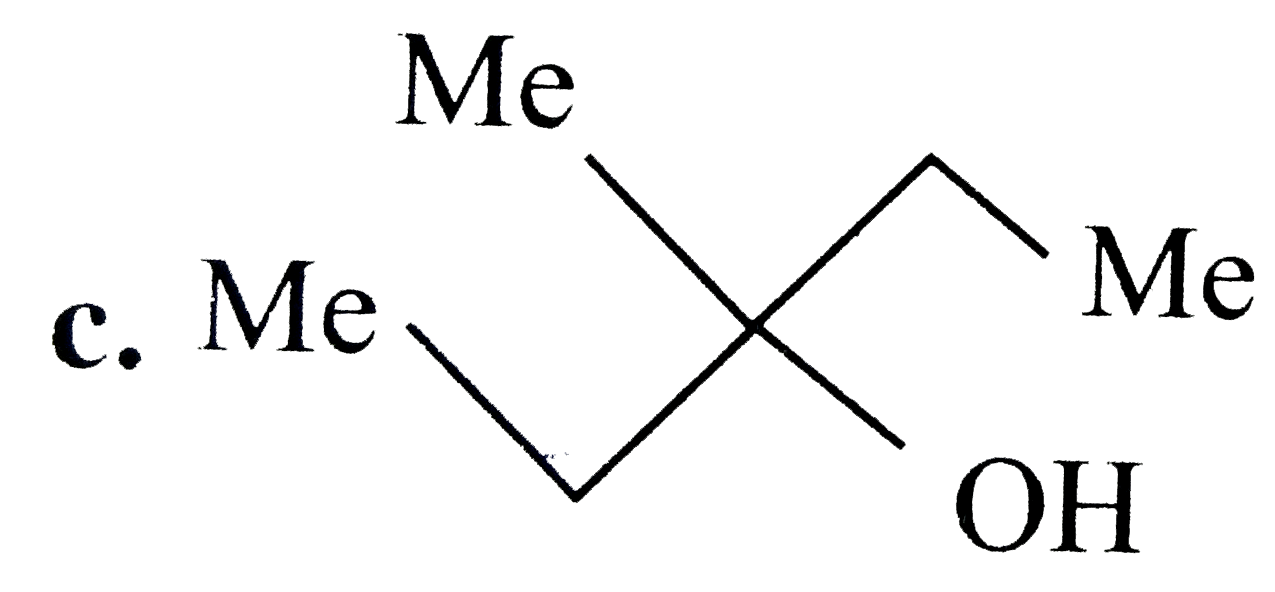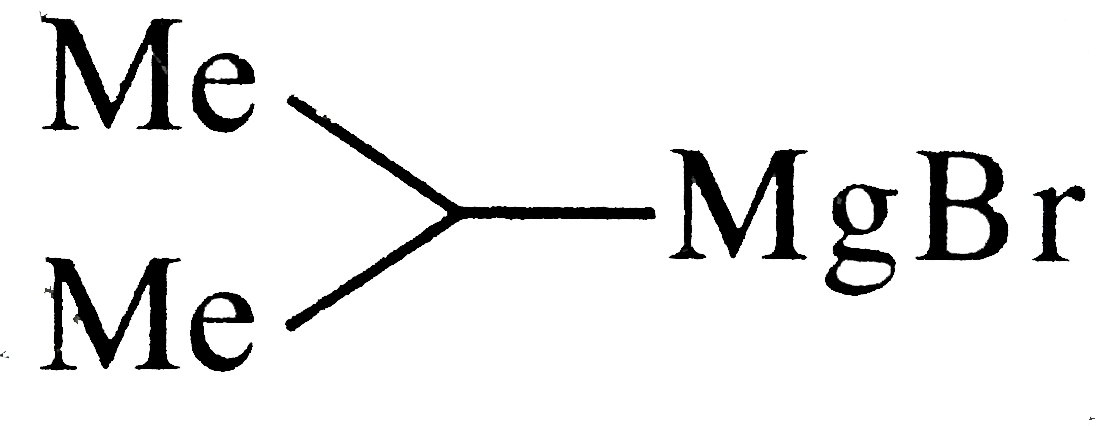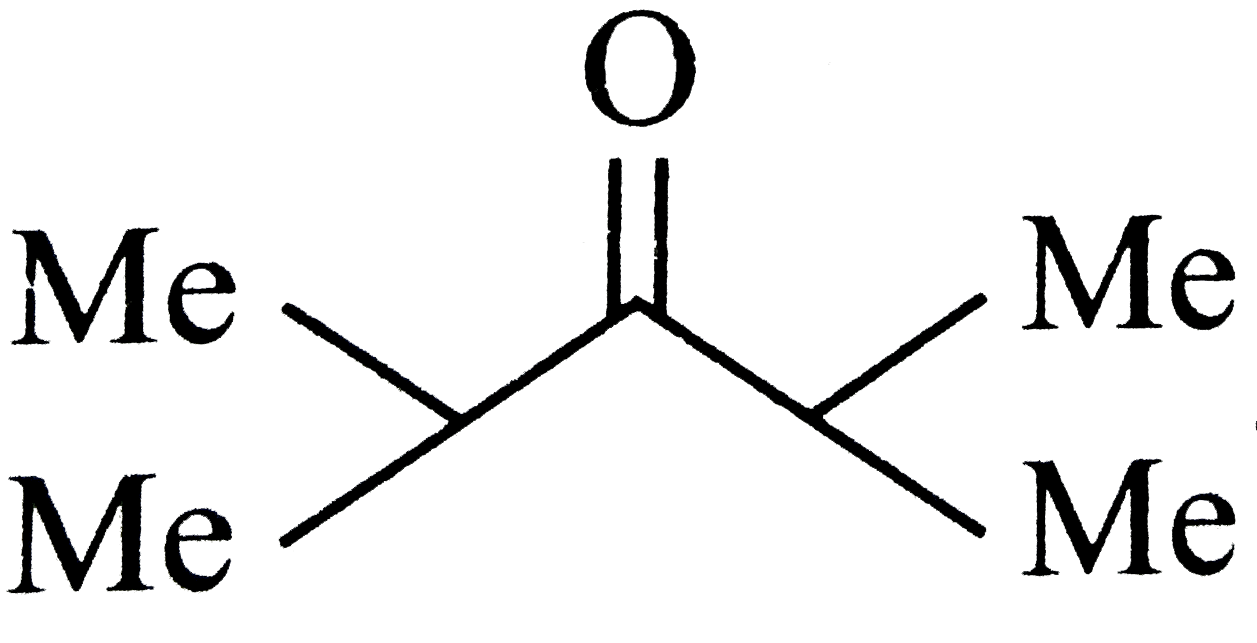When ethyl ethanoate is treated with excess of , followed by hydrolysis, the product is :




The correct Answer is:A
To solve the question, we need to understand the reaction between ethyl ethanoate and excess methylmagnesium bromide (MeMgBr), followed by hydrolysis. Here’s a step-by-step breakdown of the process:
Step 1: Identify the Reactants
The reactants in this reaction are:
- Ethyl ethanoate (CH3COC2H5)
- Methylmagnesium bromide (MeMgBr)
Step 2: First Reaction with MeMgBr
When ethyl ethanoate is treated with excess MeMgBr, the nucleophilic methyl group (CH3-) from MeMgBr attacks the carbonyl carbon (C=O) of ethyl ethanoate. This results in the formation of a tetrahedral intermediate.
Reaction:
CH3COC2H5+MeMgBr→CH3C(OMgBr)(C2H5)Me
Step 3: Formation of the Intermediate
The tetrahedral intermediate formed has a magnesium alkoxide group (OMgBr) and the ethyl group remains attached. Since we have excess MeMgBr, this intermediate can react again.
Step 4: Second Reaction with MeMgBr
The tetrahedral intermediate reacts with another molecule of MeMgBr. The methyl group attacks the carbonyl carbon again, leading to another nucleophilic addition.
Reaction:
CH3C(OMgBr)(C2H5)Me+MeMgBr→CH3C(C2H5)(Me)OMgBr
Step 5: Hydrolysis
After the reaction with excess MeMgBr, the product is hydrolyzed by adding water (H3O+). This step converts the alkoxide (OMgBr) into an alcohol.
Hydrolysis Reaction:
CH3C(C2H5)(Me)OMgBr+H2O→CH3C(C2H5)(Me)OH+MgBrOH
Step 6: Final Product
The final product after hydrolysis is:
CH3C(C2H5)(Me)OH
This compound is 2-methyl-3-pentanol.
Conclusion
The product formed when ethyl ethanoate is treated with excess MeMgBr followed by hydrolysis is 2-methyl-3-pentanol.
Answer
The product is 2-methyl-3-pentanol.
---
The reactants in this reaction are:
- Ethyl ethanoate (CH3COC2H5)
- Methylmagnesium bromide (MeMgBr)
When ethyl ethanoate is treated with excess MeMgBr, the nucleophilic methyl group (CH3-) from MeMgBr attacks the carbonyl carbon (C=O) of ethyl ethanoate. This results in the formation of a tetrahedral intermediate.
CH3COC2H5+MeMgBr→CH3C(OMgBr)(C2H5)Me
The tetrahedral intermediate formed has a magnesium alkoxide group (OMgBr) and the ethyl group remains attached. Since we have excess MeMgBr, this intermediate can react again.
The tetrahedral intermediate reacts with another molecule of MeMgBr. The methyl group attacks the carbonyl carbon again, leading to another nucleophilic addition.
CH3C(OMgBr)(C2H5)Me+MeMgBr→CH3C(C2H5)(Me)OMgBr
After the reaction with excess MeMgBr, the product is hydrolyzed by adding water (H3O+). This step converts the alkoxide (OMgBr) into an alcohol.
CH3C(C2H5)(Me)OMgBr+H2O→CH3C(C2H5)(Me)OH+MgBrOH
The final product after hydrolysis is:
CH3C(C2H5)(Me)OH
The product formed when ethyl ethanoate is treated with excess MeMgBr followed by hydrolysis is 2-methyl-3-pentanol.
The product is 2-methyl-3-pentanol.
Topper's Solved these Questions
- GRIGNARD REAGENTS AND ORGANOMETALLIC REAGENTSBOOK - CENGAGE CHEMISTRY ENGLISHCHAPTER - GRIGNARD REAGENTS AND ORGANOMETALLIC REAGENTSEXERCISE - Exercises Archives (Single Correct)
4 Videos
- GRIGNARD REAGENTS AND ORGANOMETALLIC REAGENTSBOOK - CENGAGE CHEMISTRY ENGLISHCHAPTER - GRIGNARD REAGENTS AND ORGANOMETALLIC REAGENTSEXERCISE - Exercises Archives (True/False)
1 Videos
- GRIGNARD REAGENTS AND ORGANOMETALLIC REAGENTSBOOK - CENGAGE CHEMISTRY ENGLISHCHAPTER - GRIGNARD REAGENTS AND ORGANOMETALLIC REAGENTSEXERCISE - Exercises (Multiple Correct)
16 Videos
- GENERAL PRINCIPLES AND PROCESS OF ISOLATION OF ELEMENTSBOOK - CENGAGE CHEMISTRY ENGLISHCHAPTER - GENERAL PRINCIPLES AND PROCESS OF ISOLATION OF ELEMENTSEXERCISE - Archives (Subjective)
14 Videos
- NCERT BASED EXERCISEBOOK - CENGAGE CHEMISTRY ENGLISHCHAPTER - NCERT BASED EXERCISEEXERCISE - Nuclear Chemistry (NCERT Exercise)
29 Videos
Similar Questions
Knowledge Check
Select the correct alternative from the choices given:
When acetone is treated with Grignard's reagent, followed by hydrolysis, the product formed is :ASecondary alcoholBTertiary alcoholCPrimary alcoholDAldehydeWhen acetaldehyde is treated with Grignard reagent, followed by hydrolysis the product formed is :
Aprimary alcoholBsecondary alcoholCcarboxylic acidDtertiary alcoholWhen acetaldehyde is treated with Grignard reagent, followed by hydrolysis the product formed is :
Aprimary alcoholBsecondary alcoholCcarboxylic acidDtertiary alcohol
When ethanamide is treated with EtMgBr, followed by hydrolysis, the product is :
View SolutionA long solenoid having n = 200 turns per metre has a circular cross-section of radius a1=1cm. A circular conducting loop of radius a2=4cm and resistance R=5(Ω) encircles the solenoid such that the centre of circular loop coincides with the midpoint of the axial line of the solenoid and they have the same axis as shown in Fig.

A current 't' in the solenoid results in magnetic field along its axis with magnitude B=(μ)ni at points well inside the solenoid on its axis. We can neglect the insignificant field outside the solenoid. This results in a magnetic flux (ϕ)B through the circular loop. If the current in the winding of solenoid is changed, it will also change the magnetic field B=(μ)0ni and hence also the magnetic flux through the circular loop. Obvisouly, it will result in an induced emf or induced electric field in the circular loop and an induced current will appear in the loop. Let current in the winding of solenoid be reduced at a rate of 75A/sec.
When the current in the solenoid becomes zero so that external magnetic field for the loop stops changing, current in the loop will follow a differenctial equation given by [You may use an approximation that field at all points in the area of loop is the same as at the centre
View SolutionWhen
 is treated with
is treated with  followed by hydrolysis, the product is :
followed by hydrolysis, the product is :
View SolutionWhen acetaldehyde is treated with Grignard reagent, followed by hydrolysis the product formed is :
View SolutionWhen acetaldehyde is treated with Grignard reagent, followed by hydrolysis the product formed is :
View Solution

 is treated with
is treated with